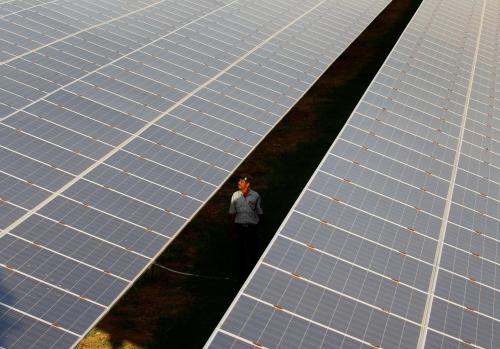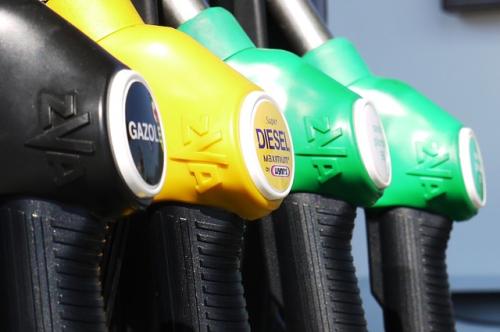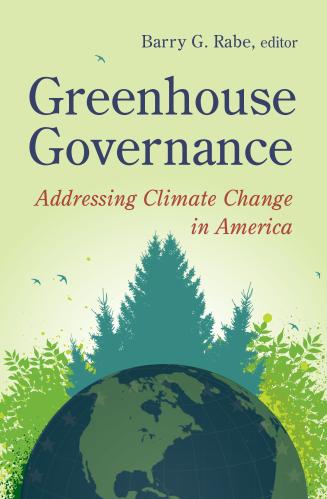Content from the Brookings Institution India Center is now archived. After seven years of an impactful partnership, as of September 11, 2020, Brookings India is now the Centre for Social and Economic Progress, an independent public policy institution based in India.
Niti Aayog needs a sharp focus on weakening the link between energy demand and environmental degradation writes Vikram Mehta
Niti Aayog has placed on the internet a 25-slide presentation entitled “Creating a movement for change”. It has set out a thematic roadmap for quintupling the GDP from the current $2 trillion to $10 trillion and for removing poverty by 2032. The language is in keeping with the thrust of “minimum government, maximum governance”. The presentation is focused on action, timeliness, coordination, implementation and monitoring. I commend its spirit. We do need to galvanise change. I also commend the fact that Niti Aayog has placed this document in the public domain, with the presumed purpose of inviting comment and criticism. There is, of course, much to criticise. Apart from the fact that there’s no mention of financing, its linearly projected targets don’t stand rigorous scrutiny. But let’s assume the authors acknowledge these shortcomings and their purpose in publishing this document is simply to create a strawman for a constructive knockdown. It’s in this vein that I suggest Niti Aayog include “t” as a core theme.
The presentation concludes with a vision statement that the “way forward” will be linked to the attainment of “sustainable development goals”. It doesn’t, however, mention the word “environment” even once. It does contain suggestions that have positive environmental implications. There’s, for instance, the recommendation of biodegradable packaging systems and there’s the theme of energy conservation and efficiency. But these suggestions are subsets of a broader theme. In the case of the former, it’s the objective of “Swachh Bharat and Ganga Rejuvenation”. For the latter, it’s to entrench further a fossil fuel-dominated energy system. There’s no focused theme on managing the environmental consequences of 10% annual growth. Accordingly, it’s difficult to understand how Niti Aayog expects to realise its vision of sustainable development.
India must accept certain hard truths. It will remain dependent on relatively polluting fossil fuels for the foreseeable future. Its electricity demand will be met predominantly from thermal power plants; its burgeoning transportation sector will be fuelled by gasoline and diesel; and its industrial, commercial and residential establishments will turn increasingly to gas. Solar and wind will no doubt make distributed inroads but their contribution will account for a relatively small percentage. Similarly, hydro and nuclear will show robust growth but not materially reduce the dependence on fossil fuels. In consequence, India will face two sharp vulnerabilities. The first will be because of the growing import dependence on a geopolitically volatile Middle East for crude oil supplies and the second because of environmental stress. The hard truth is unless and until these two vulnerabilities are effectively tackled, India will not come close to the projected targets of the presentation.
The issue of oil supply security will require creative energy diplomacy. India will need to leverage its “monopsonistic” bargaining leverage to get the best commercial terms and, at the same time, it will have to navigate the antagonisms that divide two of our most important strategic suppliers, Sunni Saudi Arabia and Shia Iran. This is a task best managed by the petroleum ministry and the external affairs ministry. The issue of environmental damage will require the creation of an ecosystem that incentivises collaborative public-private investment in “greening” fossil fuels and clean-energy innovation. This could be spearheaded by Niti Aayog.
Investment in clean energy is not a slam dunk economic proposition. The recent bankruptcy of the solar company Sun Edison brings this into sharp relief. Governments and public-sector entities have to provide the catalyst. This is what the US government has done for years and the Chinese government has begun recently. Niti Aayog should draw the appropriate lessons from these experiences.
An example from the US is illustrative. The Pentagon wanted to develop robotic vehicles. To harness the scientific and technical talent of the private sector, universities and research laboratories towards this goal, it sponsored a race in 2004 between 15 driverless vehicles across 150 miles of the Mojave Desert in California. It offered a $1-million prize. The results were underwhelming. No vehicle completed the race. In fact, none covered more than 10% of the distance. They sponsored a second race the following year. They doubled the prize money but set a more difficult route, involving hairpin turns, sheer drop-offs and three tunnels. The results were impressive. Five cars completed.
This success triggered private-sector interest and, today, Google and almost every major auto company are investing in the development of robotic, autonomous and semi-autonomous vehicles.
At a macro level, the China experience is also worth examining. China has been the locomotive of the global economy for the past two decades and, while the world marvelled, Chinese urbanites have choked under a blanket of smog. Beijing had acquired the dubious ranking of being among the most polluted cities in the world. Three years back, the government shifted its energy gears. It put a break on inefficient thermal power plants and provided subsidies for investment in solar, wind and clean energy. The result is now tangibly evident. Beijing is ranked 76 in the WHO’s ordering of the most polluted cities (in terms of PM2.5) and BYD Shenzhen is the largest marketer of electric vehicles in the world.
India cannot read from the same script as the US or China. Our developmental model is different. But it can draw appropriate lessons. Sustainable growth will require the catalytic impetus of government for investments in clean energy and innovation. Niti Aayog’s movement for change requires a laser focus on weakening, if not breaking, the connect between energy demand and environmental degradation. It must now develop the roadmap for doing so.
This article first appeared in The Financial Express and The Indian Express on May 2, 2016. Like other products of the Brookings Institution India Center, this is intended to contribute to discussion and stimulate debate on important issues. The views are those of the author.
The Brookings Institution is committed to quality, independence, and impact.
We are supported by a diverse array of funders. In line with our values and policies, each Brookings publication represents the sole views of its author(s).









Commentary
Op-edSustainable development goals must be linked to energy and environment
The Indian Express | The Financial Express
May 2, 2016